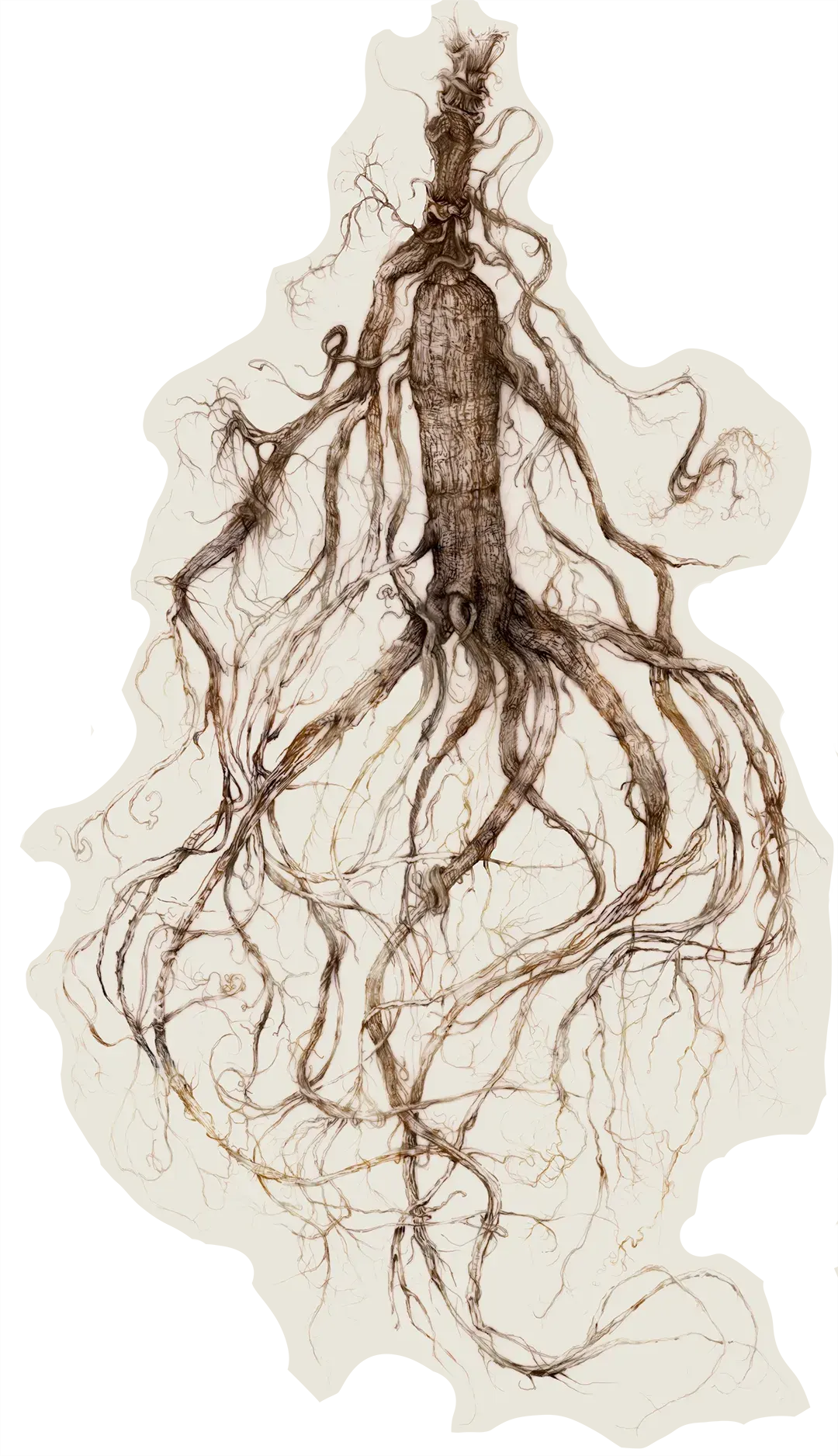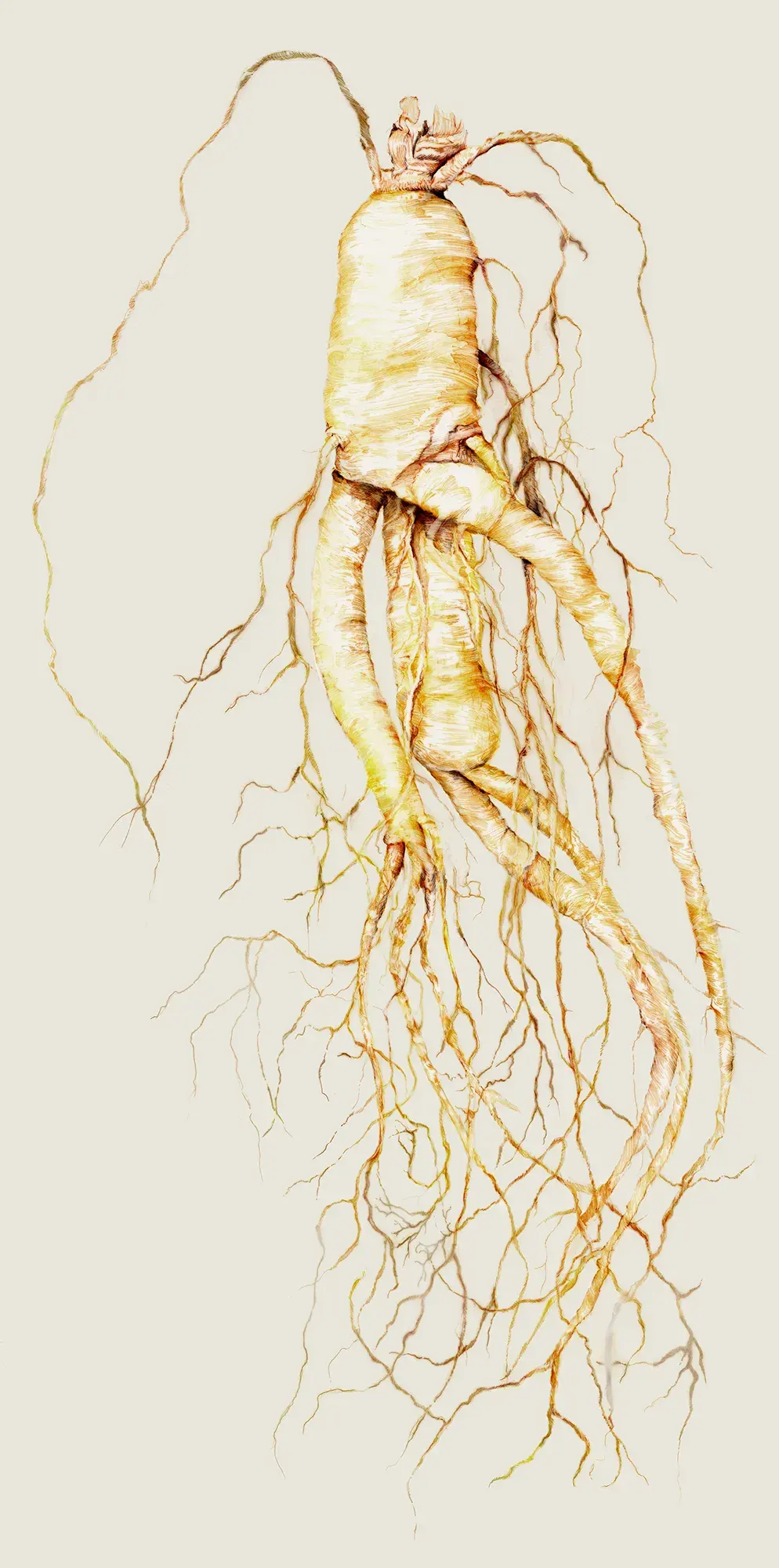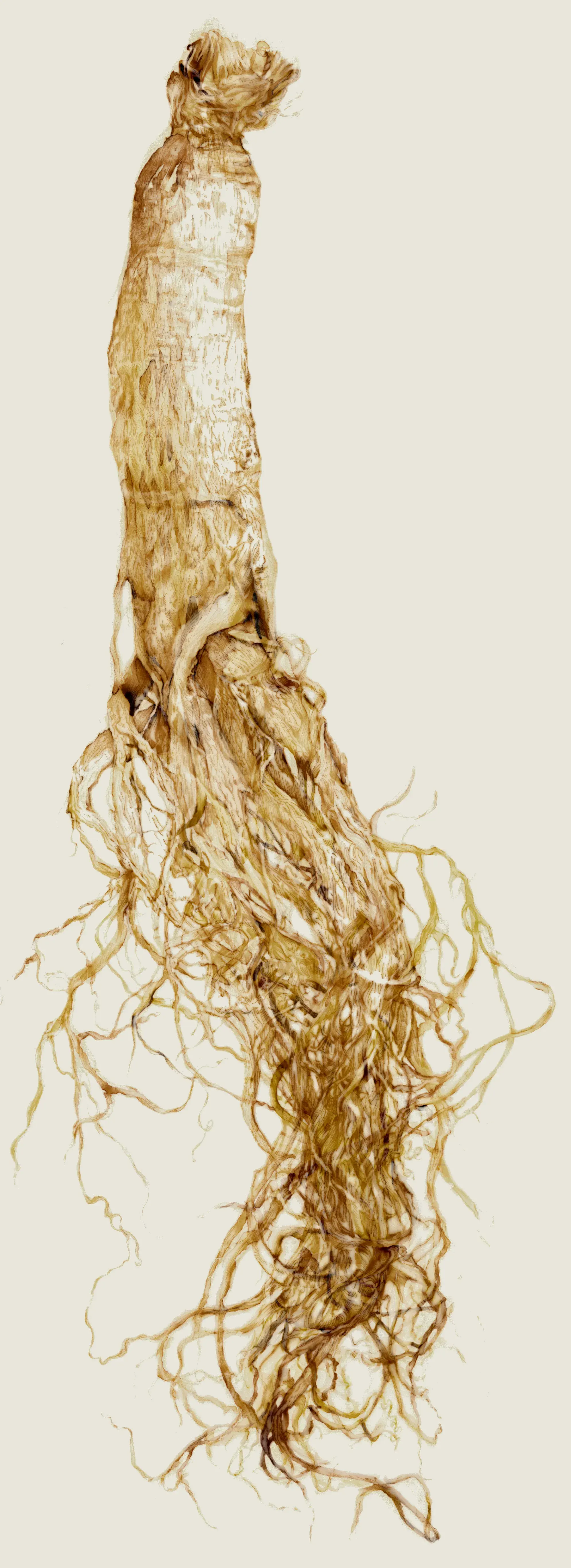Ginseng sourcing
With a global market estimated at 80,000 tons per year and a medicinal use spanning over 4 millennia, Korean ginseng is one of the most valuable top selling botanicals in the world, and most of all: a medicinal plant whose history and tradition are deeply intertwined with that of humanity.

Origins & species
Korean ginseng (Panax ginseng C.A. Meyer) has been considered one of the pillars of traditional Asian medicine for several millennia. Its first recorded mention dates back to around 2700 BC, in the pharmacopeia of the father of Chinese medicine, Emperor Shen Nung. Ginseng was then praised for its tonic, longevity and aphrodisiac virtues, and described as the greatest herbal medicine of all.
But the importance of ginseng goes far beyond its medicinal value: for centuries, its immeasurable prestige in the time of Imperial China made it a prized luxury reserved only for the wealthy and noble. Over time, the gradual rarefaction of its highly coveted roots placed ginseng at the heart of important political and economic stakes; access to this precious resource has profoundly shaped economic and geopolitical international relations throughout the history of Asian societies.
Today, the high cultural and market value of Korean ginseng have made it one of the most expensive herbs on the market, while also making the precious herb a golden-target for adulteration.
Ginseng adulteration is indeed quite common on the market of herbal products; a recent study estimated that no less than 24% of 507 ginseng-containing products sold across 12 countries were either mislabeled of adulterated, failing botanical and / or chemical identification tests (Ichim et al., 2020).

A number of morphologically or pharmacologically similar botanicals are frequently being passed off as “ginsengs”, taking advantage of Korean ginseng’s prestige and high price, but falling short in delivering its unique benefits.
For those seeking the unique benefits of this highly coveted herb, DNA and chemical analysis can be valuable tools to ensure the absolute authenticity and purity of ginseng products.
Cultivation methods
-

The wild grail
Wild ginseng has been traditionally harvested in the temperate mountain forests of Manchuria for thousands of years. In nature, ginseng thrives in the rich soil and humid shaded environment of its biotopes of origin; and these environmental challenges are crucial to the accumulation of bioactive molecules in the roots.
Despite being considered the highest standard for quality and purity in the world, Korean ginseng has been heavily overharvested for centuries, resulting in a significant decline of its wild reserves. With the majority of natural stocks now endangered or extinct, this wild herb has become an incredibly scarce and costly good on the market, with prices reaching tens to hundreds of thousands of dollars.
Unsurprisingly, it was the need to regenerate dwindling wild stocks that sparked the first attempts to ginseng cultivation. Wild-simulated ginseng, a method that is still practiced today, involved propagating of planting ginseng in mountainous and remote areas of Korea, so that the plant could grow in its rich and shady forest environments of origin.
While this method ensures sustainable harvest and the preservation of the valuable high-quality wild-sourced botanical, it falls short in terms of scalability. In addition, long cultivation times (10 years) and low batch to batch consistency in terms of bioactive composition remain key contributors to the high prices.
-

Field-grown
First developed by Koreans, traditional ginseng cultivation yields pharmacologically active roots after an average of 4 to 6 years. In addition to a relatively stable and shaded environment, often set up with field covers, ginseng requires a highly nutrient-rich soil to grow, and therefore frequent soil rotation.
From a compositional point of view, cultivated ginseng shows a significantly poorer bioactive profile, which usually leads to a subsequent extraction process to enhance the ingredients pharmacological effectiveness.
Intensive agriculture has made access to this prized remedy explode. However, in countries like South Korea, the prestige of wild harvested roots and the centuries-old expertise in their production and processing remain the unmatched benchmark for world-class ginseng quality.
Types of products
Traditional ginseng processing has been around for centuries; Koreans started drying and cooking ginseng roots as a way of extending their shelf-life to up to 20 years. Perfected over centuries, these age-old methods are still used today to preserve the extraordinary properties of the coveted roots.
The type and degree of processing have also traditionally been associated with more potent health benefits, as explained by the significant chemical changes they induce in the bioactive matrix. The bioactive compounds found in ginseng do indeed play a significant role in determining the products quality and pharmacological effectiveness; each type of processed ginseng has a unique ginsenosides "fingerprint", which can be used to confirm its authenticity and correct identification.
-
Fresh ginseng
Often used in traditional food preparations across Asia, fresh ginseng roots are naturally rich in water-soluble precursor ginsenosides forms like Rg1 and Rb1.
Despite it being a great source of vitamins, enzymes and other beneficial nutrients for health, fresh ginseng is a perishable product and is therefore rarely consumed as such.

-
White ginseng
Sun-drying is the oldest method of processing ginseng. The resulting product, known as white ginseng, is the most common type of ginseng on the Chinese market.
The process involves a simple drying of the ginseng roots, traditionally in the sun, and removes 75% of their water content. Contrary to other methods, sun-drying does not significantly alter ginsenosides (it just concentrates them), and thus preserves the root’s bioactive composition.

-
Red ginseng
Red ginseng is obtained by steam cooking of the ginseng roots for 1 to 3 cycles. The heat causes the browning (Maillard reaction) of the roots due to their high content in polysaccharides, giving ginseng a characteristic reddish color.
In addition, the root’s bioactive matrix undergoes significant transformations under the effect of heat and water. Precursor ginsenosides like Rg1 and Rb1 are partially converted into more bioactive derivatives, also referred to as rare or noble ginsenosides (Rg3, Rg5 and Rk1).

-
Black ginseng
Often used in traditional food preparations across Asia, fresh ginseng roots are naturally rich in water-soluble precursor ginsenosides forms like Rg1 and Rb1.
Black ginseng is obtained by cooking ginseng roots for between 4 and 9 steam cycles. The higher degree of cooking darkens the roots color to dark black tones and accentuates the degree of bioconversion of common ginsenosides into their bioactive forms, especially dehydrated forms like Rg5 and Rk1.

Often used in traditional food preparations across Asia, fresh ginseng roots are naturally rich in water-soluble precursor ginsenosides forms like Rg1 and Rb1.
Despite it being a great source of vitamins, enzymes and other beneficial nutrients for health, fresh ginseng is a perishable product and is therefore rarely consumed as such.
Ginseng Full-Spectrum vs. Standardized Extract
Like many adaptogens, ginseng’s effectiveness relies on a wide variety of bioactive compounds. While its best-known phytoactive fraction is that of ginsenosides, ginseng’s bioactive matrix is also composed of an important polysaccharide fraction (including panaxan and ginsan), specific bioactive proteins (gintonin) and many other active compounds, including alkaloids, phytosterols, phenolic acids, and amino acids.
Each family of bioactive molecules shows potent health benefits of its own, but they also display strong synergistic effects. For instance, research shows that polysaccharides exert microbiotic and immunomodulatory effects, complementary to the bioactivity of secondary metabolites like ginsenosides.
At BOTALYS, we believe that the secret behind the health benefits of any adaptogen lies in the simultaneous richness, diversity and stability of its bioactive profile. In practice, there are compromises to be made no matter which type of ginseng ingredient is chosen:

Only a rich highly standardized full-spectrum ginseng can deliver the whole range of its adaptogenic benefits.

Reaching new heights
Thanks to its innovative proprietary technology, BOTALYS is able to produce the most pristine quality botanicals in the world.
From absolute purity to complete standardization, BOTALYS has taken up the bold challenge of ticking all the boxes of an ideal botanicals supply. So that our clients no longer have to choose between quality, effectiveness and sustainability.
